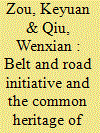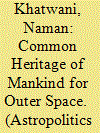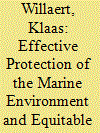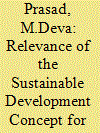|
|
|
Sort Order |
|
|
|
Items / Page
|
|
|
|
|
|
|
| Srl | Item |
| 1 |
ID:
163435


|
|
|
|
|
| Summary/Abstract |
With the development of global science and technology, the international legal concept of “the common heritage of mankind” (CHM) encounters some dilemma in practice. This editorial comment attempts to discuss the ongoing developments of the CHM concept in the context of the Belt and Road Initiative (BRI) put forward by China, and then the interplay between the two concepts. It is argued that the inherent elements of the CHM concept, such as co-management, co-benefit, and co-participation, are well reflected in the BRI. Moreover, the BRI can also reinforce the dynamic extension of the CHM concept in the above three key elements. As a new international public good, the BRI is aimed at reasonable allocation and sharing of international resources following the CHM concept, and correspondingly this concept can strengthen the theoretical basis of the BRI facilitating its entry into the centre of the international stage
|
|
|
|
|
|
|
|
|
|
|
|
|
|
|
|
| 2 |
ID:
167856


|
|
|
|
|
| Summary/Abstract |
The paper examines the intention of the drafters of the Outer Space Treaty regime to advance from the principle of “common province of mankind” and adopt “Common Heritage of Mankind”. In this context, the drafting history of the Moon Agreement, which helps discern the meanings ascribed to Common Heritage of Mankind by various countries, is considered. Moreover, the usage of the term in other realms, such as the deep seabed regime and Antarctica, is essential to understand the concept. The introduction of Common Heritage of Mankind in the United Nations Law of the Sea led to various industrialized developed countries, including the United States, to oppose the law. Hence, the approach was diluted to ensure it converts into a more liberal condition that does not enforce strict mandates on parties to the Law of the Sea. A similar view of states exists with respect to the Moon Agreement resulting to date in only 17 ratifications by states with no spacefaring states among them. Consequently, most states argue that the Common Heritage of Mankind principle in the Moon Agreement is not applicable due to not being party to the agreement. It is also argued that since there is no state practice suggesting opinion juris regarding Common Heritage of Mankind, it is not part of customary international law. The non-inclusion of the principle as a customary norm makes the relevance of Common Heritage of Mankind in the present world debatable and uncertain.
|
|
|
|
|
|
|
|
|
|
|
|
|
|
|
|
| 3 |
ID:
172435


|
|
|
|
|
| Summary/Abstract |
The international legal framework with regard to “the Area,” comprising the deep seabed and the subsoil beyond the boundaries of national jurisdiction, has been modified significantly through the years. It was first established by part XI of the United Nations Convention on the Law of the Sea, but the 1994 Implementation Agreement introduced several changes. These general rules and principles are further developed in the “Mining Code,” referring to the comprehensive set of regulations and procedures issued by the International Seabed Authority. The Authority has already produced rules for the first phases of mining activities (prospecting and exploration) in the Area, but has yet to adopt exploitation regulations. Nevertheless, the most recent draft of the exploitation regulations provides a good indication of the current state of play. This article analyzes the current draft of the exploitation regulations, which will shape the future deep seabed mining regime, in order to evaluate whether the relevant provisions are sufficient and effective to attain two prominent goals with regard to the Area: the protection of the marine environment and the equitable sharing of financial and economic benefits. The Law of the Sea Convention indeed states that the resources of the deep seabed are considered common heritage of mankind and prioritizes these objectives. Therefore, the exploitation regulations should strike an appropriate balance between commercial exploitation, environmental protection, and the interests of developing countries. The strengths and weaknesses of this document and the overarching international legal framework are identified and possible corrections are suggested.
|
|
|
|
|
|
|
|
|
|
|
|
|
|
|
|
| 4 |
ID:
108590


|
|
|
|
|
| Publication |
2011.
|
| Summary/Abstract |
The establishment of the outer limits of the continental shelf not only involves the rights and interests of coastal states, but also the interests of the international community as a whole. This article examines this balance between coastal states' assertions of their outer continental shelf limits and the common heritage of mankind.
|
|
|
|
|
|
|
|
|
|
|
|
|
|
|
|
| 5 |
ID:
169309


|
|
|
|
|
| Summary/Abstract |
This article provides an analysis of the concept of sustainable development in the context of current international space law. The extent of doctrinal conflicts and consensus of the international space law conventions and instruments with the concept of sustainable development could be well understood from this analysis. The result clearly indicates that there is consonance between the legal concept of sustainable development and international space law framework. At the same time, the article points out that the various issues relating to the long-term sustainable use of outer space and concerns faced because of a gap in international space law still exist. To curb this problem, it is important to improve the normative nature of international space law. The analysis helps in highlighting that incorporating the legal concept of sustainable development in a proactive manner into international space law would help in increasing the normative character as well as increasing its effectiveness.
|
|
|
|
|
|
|
|
|
|
|
|
|
|
|
|
|
|
|
|
|